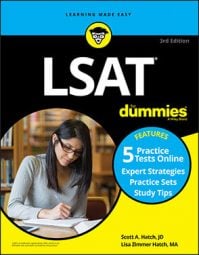The LSAT expects you to understand the basics of a good argument. Individuals who argue use a variety of tactics to make their points and disarm their opponents. They may deny something the other person says, challenge their opponent’s evidence, explain what they mean, or use analogies to illustrate their points. Lawyers use these tactics all the time.
How to identify structure questions
A number of logical reasoning questions focus on the structure of arguments. These questions usually involve two speakers who disagree with each other in some way. The question usually asks you to explain how the second speaker responds to the first. These questions can look like this:
Yolanda responds to Javier by…(arguing, denying, using analogy, challenging, showing evidence)
In responding to Penelope, Odysseus…(accuses, criticizes, challenges, explains, assumes)
Carter counters Yvette’s argument by…(questioning, suggesting, denying, pointing out, calling into question)
This advertisement proceeds by…(using analogy, proving, understating the role, demonstrating, asserting)
Seth challenges Arne’s reasoning by…
Kelsey’s criticism suggests that he interpreted Mac to be…
Landrieu and Blanco disagree about whether…
Marquis responds to Theodora’s argument in which one of the following ways?
Rinn responds to Julio’s criticism by…
Your goal is to figure out how the second speaker’s argument relates to the first. The second speaker addresses the first speaker in some way; you have to figure out how. If there’s only one speaker, you simply have to describe how the speaker constructs the argument.
A structure-of-argument example
Here’s an example of a structure-of-argument question:
Gabrielle: The man who invented the shopping mall in the United States envisioned it as the heart of a pedestrian community, much like the centers of European towns, with their sidewalk cafes, boutiques, and pleasant boulevards. Malls now provide a safe environment in which people can walk from shop to shop and meet with their friends.
Antonia: Although people walk within a mall, the very existence of the shopping mall has killed pedestrian culture. American town centers are now wastelands where no one goes, and malls themselves exist in the center of massive parking lots. People isolated in their cars drive to suburban malls and then wander around the mall ignoring and avoiding their fellow shoppers.
Antonia responds to Gabrielle by
(A)arguing that the invention of the mall has led to consequences that are exactly opposite what the mall’s inventor intended
(B)proposing that sensible urban planning could result in the shopping mall becoming a positive force in communities
(C)using an analogy to illustrate the detrimental effects of malls
(D)pointing out that European cities now have shopping malls in their suburbs
(E)explaining why American cities have developed in such a way that private automobiles are the only practical form of transportation
Read the question first. It asks how the second speaker responds to the first. The answers to this sort of question always start with verbs, such as criticize, argue, point out, and things like that. You want to decide for yourself how Antonia responds before you start reading the answer choices.
Gabrielle suggests that the shopping mall has evolved as its creator envisioned — as a safe, enclosed, walkable community. Antonia disagrees with her, contending that malls have ended pedestrian culture and community spirit. So you want to find an answer that disagrees with Gabrielle’s argument and claims that the mall isn’t the institution its creator imagined.
Choice (A) looks like exactly the answer you want; Antonia does argue that the mall’s consequences are opposite those intended by its creator.
Choice (B) is wrong because Antonia doesn’t mention sensible urban planning.
Choice (C) is wrong because Antonia doesn’t use an analogy.
Choice (D) is wrong because Antonia doesn’t mention Europe.
Choice (E) is wrong because Antonia doesn’t mention automobiles.
Choices (B) through (E) all bring up points that Antonia might use if she were to continue her argument, but they’re not relevant here. Choice (A) is the correct answer.

